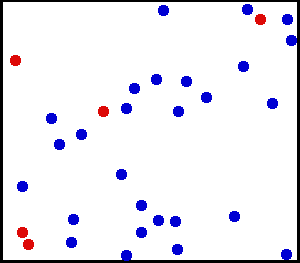Kinetic theory facts for kids
The kinetic theory of gases helps us understand how gases behave. It explains big things like pressure, temperature, and volume by looking at the tiny molecules that make up the gas. This theory says that pressure isn't caused by molecules pushing each other away. Instead, it's caused by molecules bumping into each other and the sides of their container.
This idea is also called the kinetic-molecular theory or collision theory. It helped scientists figure out many important ideas in thermodynamics, which is the study of heat and energy.
There are three main ideas in the kinetic theory:
- Molecules don't lose or gain energy when they crash into each other.
- The molecules in a gas take up almost no space compared to the container they are in.
- Gas molecules are always moving in straight lines.
Contents
History of Gas Theory
Early Ideas About Moving Atoms
Around 50 BCE, a Roman thinker named Lucretius suggested that even still objects are made of tiny, fast-moving atoms. He thought these atoms were always bouncing off each other. However, this idea wasn't very popular for a long time. Most people followed the ideas of Aristotle instead.
Key Scientists and Their Discoveries
In 1738, Daniel Bernoulli wrote a book called Hydrodynamica. This book laid the groundwork for the kinetic theory of gases. Bernoulli suggested that gases are made of many molecules moving in all directions. He believed that when these molecules hit a surface, they create the gas's pressure. He also thought that the average speed of these molecules determined the gas's temperature. But his ideas weren't accepted right away.
Other scientists also worked on these ideas, but their work was often overlooked. These included Mikhail Lomonosov (in 1747) and Georges-Louis Le Sage (around 1780). Later, John Herapath (1816) and John James Waterston (1843) also made important contributions.
In 1856, August Krönig created a simple model of gas movement. A year later, in 1857, Rudolf Clausius developed a similar but more detailed theory. Clausius also introduced the idea of the mean free path. This is the average distance a particle travels before it hits another particle.
Maxwell and Boltzmann's Contributions
In 1859, a Scottish physicist named James Clerk Maxwell read about Clausius's work. Maxwell then came up with the Maxwell–Boltzmann distribution. This was the very first statistical law in physics. It described how the speeds of molecules in a gas are spread out.
Later, in 1871, Ludwig Boltzmann expanded on Maxwell's work. He further developed the Maxwell–Boltzmann distribution.
Proving Atoms Are Real
At the start of the 1900s, many physicists still thought atoms were just ideas, not real things. A big change happened with papers by Albert Einstein (1905) and Marian Smoluchowski (1906). They wrote about Brownian motion, which is the random movement of particles in a fluid. Their work used the kinetic theory to make accurate predictions. This helped prove that atoms and molecules are indeed real.
After the Boltzmann equation was developed, David Enskog (1917) and Sydney Chapman (1916) independently created ways to use it. Their work helped develop equations for how things like heat and momentum move through gases.
Assumptions of Kinetic Theory
When we use the kinetic theory to understand ideal gases, we make a few assumptions:
- Gases are made of very tiny particles. These particles are so small that their total volume is tiny compared to the volume of the container. This means there's a lot of empty space between gas particles. Also, the time it takes for a particle to hit a wall is very short compared to the time between hits.
- There are so many particles that we can use statistics to study them. This is like saying we have enough data to make good predictions about their behavior.
- The fast-moving particles are always bumping into each other and the container walls. All these collisions are perfectly elastic. This means no energy is lost during the bumps, like perfect bouncy balls.
- Except when they are colliding, the molecules don't really interact with each other. They don't pull on each other or push each other away.


